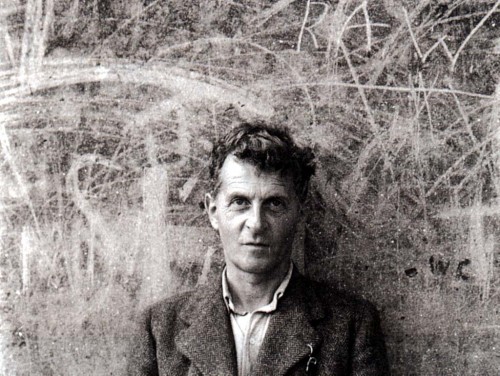Wittgenstein Tweets
“Russell wants me to provide ‘arguments’ for my positions
i.e. he wants me to spoil their beauty.”
(1912, aged 23)
The aim of Wittgenstein Tweets is to introduce the entire life of Ludwig Wittgenstein in around 500 tweets over 6 months. Yes, a silly project, and one which Wittgenstein himself would have almost certainly loathed.
I am doing it purely because I find Ray Monk’s biography (1990) of Wittgenstein so captivating and hilarious that I want more people to get to know him. No love for or knowledge of Wittgenstein is necessary.
via Zeph Auerbach
I Used to Play in Bands
Bill Roorbach — nature writer, story writer, elder statesman, and Mr. Companionable (if his literary voice is to be trusted) — has shed the curmudgeonly Luddite persona he adopted in the early years of the Internet. Big time, too. Together with David Gessner, editor of Ecotone (which is a damn good magazine), he’s launched Bill and Dave’s Cocktail Hour, where he’s blogging, trading punches (but mostly kisses) with Gessner, and, best of all, posting a massive “video memoir” in irregular installments, as he completes the installments. The project, titled “I Used to Play in Bands,” chronicles his present family-man life in rural Maine alongside reminiscences of his wilder past life as a carpenter, piano player, and aspiring writer in New York and other places. It’s simply done, and strangely hypnotic.
Here’s Chapter 13. To see the rest, you’ve got to visit I Used to Play in Bands.
httpv://www.youtube.com/watch?v=mQ5YQPVCb4Q&feature=player_embedded
Noah Cicero on the “Anti-Intellectual”
Someone on my Facebook suggested that Internet Literary Writers are not intellectuals.
That they are actually anti-intellectual.
They stated that we speak nonsense.
That it isn’t helping the culture.
I went to the park and sat on a swing for two days wondering, “Am I anti-intellectual? What does it mean to be anti-intellectual? And if I am being anti-intellectual, how am I doing such a thing?”
Then I read some Sam Pink to see, I read this line, “I went to the cantaloupe section and looked at the cantaloupes.”
I stared at the line for a long time. I even counted the syllables. I counted 16 syllables. It has a little meter but not much. I could see the word cantaloupes repeated. Sam Pink is trying to imply the absurdity of cantaloupes to us. A strange round plant that is like a vegetable because it grows on the ground but is actually a fruit because the seeds are contained inside of it. Maybe he is putting out a metaphor here, a fruit that grows like a vegetable. Perhaps Sam Pink is saying he is confused about his identity like the cantaloupe is about his.
The strangest thing about the cantaloupe line is the etymology of the word “cantaloupe.” The word cantaloupe comes from the Latin word Cantalupe. Even if you know a little Spanish you can see quickly that canta lupe means “singing wolf.” Perhaps Sam Pink is trying to convey that he is like the Cantaloupe a “singing wolf.” But to go deeper a “lupe” was a prostitute in ancient Rome, so maybe Sam Pink is also saying that he is a prostitute to modern America’s corporate capitalism and even though he is suffocated by inverted-totalitarianism he will still sing his song.
And strangely it goes into Heidegger’s idea of Being. As soon as the character enters the grocery store, he knows his next move into the future. He knows his habits. He goes forward in a predictable mechanical fashion. But at the same time of being in the modern world of gadgets he needs the most primitive of things, food.
As Socrates said in Plato’s Apology,
When I left the politicians, I went to the poets; tragic, dithyrambic, and all sorts. And there, I said to myself, you will be detected; now you will find out that you are more ignorant than they are. Accordingly, I took them some of the most elaborate passages in their own writings, and asked what was the meaning of them – thinking that they would teach me something. Will you believe me? I am almost ashamed to speak of this, but still I must say that there is hardly a person present who would not have talked better about their poetry than they did themselves. That showed me in an instant that not by wisdom do poets write poetry, but by a sort of genius and inspiration; they are like diviners or soothsayers who also say many fine things, but do not understand the meaning of them. And the poets appeared to me to be much in the same case; and I further observed that upon the strength of their poetry they believed themselves to be the wisest of men in other things in which they were not wise. So I departed, conceiving myself to be superior to them for the same reason that I was superior to the politicians.
5,000 years in a small hut in The Fertile Crescent a guy writes some lines in Cuneiform and shows his friend and his friend responds, “That isn’t correct Cuneiform, you have to write like this.” And that was the first literary argument.
Possible Literary Origin of Most-Often-Uttered Phrase on ESPN “It is What it is.”

Sentence One of V.S. Naipaul’s A Bend in the River:
“The world is what it is; men who are nothing, who allow themselves to become nothing, have no place in it.”
I Wrote a Dissertation and I Will Tell You All About It

I spent the past year and a half of my life writing a dissertation. It is about 250 pages long and is filled with thrilling news from the land of Foucault and Etienne Wenger and other such folk. For a long time, I thought my dissertation sucked but I had to defend it a few weeks ago and so I re-read it to remind myself of what I had said and I realized that it didn’t suck. It’s not publication ready, no dissertation ever is, but I’m excited about what I found in my research.
Writing a dissertation is a strange thing. When I first set about the task, I was certain it would be easy because I am arrogant and academic-related things come easily to me and I assumed that this would be one more thing that came easily. I could not have been more wrong. Writing the dissertation was the second hardest thing I’ve ever done, as it should be. It was a miserable, torturous endeavor. I was overwhelmed by the futility of all, conducting an overly ambitious research project, tying practice to theory, writing something fewer than 20 people will probably ever read, knowing ultimately, it wouldn’t be what I wanted it to be, feeling like I was stating the obvious rather than contributing unique scholarship. There were times when I genuinely thought, well, if all else fails, I can move home and work for the family business. That literally became an option. I entertained elaborate fantasies of hanging out with my mother, running errands with her at Costco, sunning on the lanai. Those fantasies got me through the darkest days, of which there were many.
Widows’ Work

This sentence–“David was a big sweater, and I just remember the sweat marks on his pillow when I changed the cases”–I just feel it in my gut. And then there was this, also from last week. Can the “artistic value” of the work of the widow, the work that specifically pertains to the widow’s widowhood, ever eclipse the grief itself, the heartbreak-response of the audience? Can such work ever obtain its own terms? No, it seems to me. Which is also sort of heartbreaking, or at least one tentacle of the heartbreak.
Geography Thursdays #3: Bill Rankin’s Radical Cartography
Bill Rankin’s maps are not only representations of physical landscapes. They also attempt to explain how people live in the places they live, and the social and political implications of what his maps show is difficult to dodge. The maps are confrontational. They uncover the everyday things that our individual geographic habits might hide from us. To see more of Rankin’s maps, click here.
The map above is part of Rankin’s WIMBY v. NIMBY series, which he describes like so:
Another take on the fragmented racial landscape of American urbanism, inspired a bit by Debord’s classic cut-up psychogeographical maps of Paris. Segregation creates cities-within-cities, islands and seas of inclusion and exclusion.
All maps show the same portion of greater New York — an area about 40 miles square, centered on Manhattan.
Compared to other American cities, however, New York does have many areas of genuine diversity, where the well-armed not-in-my-backyarders compete with the fiesty and loosely organized welcome-into-my-backyard brigade. The battle of the NIMBYs and the WIMBYs continues apace.
Note: “Diversity” here indicates the chance that two randomly chosen residents will be of different races or ethnicities — i.e., the Gibbs/Martin/Blau index of diversity. All data from the 2000 U.S. Census.


